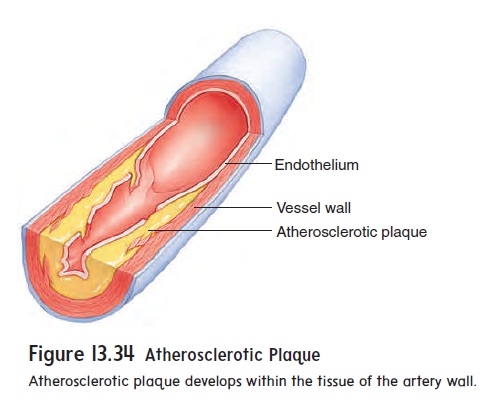Chapter: Essentials of Anatomy and Physiology: Blood Vessels and Circulation
Effects of Aging on the Blood Vessels
EFFECTS OF AGING ON THE BLOOD VESSELS
The walls of all arteries undergo changes as people age. Some arter-ies change more rapidly than others, and some individuals are more susceptible to change than others. The most significant effects of aging occur in the large, elastic arteries, such as the aorta; in large arteries carrying blood to the brain; and in the coronary arteries.
Changes in arteries that make them less elastic, referred to as arteriosclerosis, occur in nearly every individual, and become more severe with advancing age. A type of arteriosclerosis called atherosclerosis (ath′er-ō-skler-ō′sis) results from the deposition ofmaterial in the walls of arteries that forms plaques (figure 13.34). The material is composed of a fatlike substance containing cho-lesterol. The fatty material can eventually be dominated by the deposition of dense connective tissue and calcium salts.

Several factors influence the development of atherosclerosis. Lack of exercise, smoking, obesity, and a diet high in cholesterol and fats appear to increase the severity of atherosclerosis and the rate at which it develops. Severe atherosclerosis is more prevalent in some families than in others, which suggests a genetic influ-ence. Some evidence suggests that a low-fat diet, mild exercise, and relaxation activities slow the progression of atherosclerosis and may even reverse it to some degree.
Atherosclerosis greatly increases resistance to blood flow because the deposits narrow the inside diameter of the arteries. The added resistance hampers normal circulation to tissues and greatly increases the work the heart must perform. Furthermore, the rough atherosclerotic plaques attract platelets, which adhere to them and increase the chance of thrombus formation.
Capillaries narrow and become more irregular in shape with age. Their walls become thicker, and consequently the efficiency of capillary exchange decreases.
Veins tend to develop patchy thickenings in their walls, result-ing in narrowing in these areas. The tendency to develop varicose veins increases with age (see Clinical Impact earlier), as does the tendency to develop hemorrhoids (varicose veins of the rectum or anus) because some veins increase in diameter due to weakening of the connective tissue in their walls. There is a related increase in the development of thromboses and emboli, especially in veins that are dilated or those in which blood flow is sluggish.
Related Topics